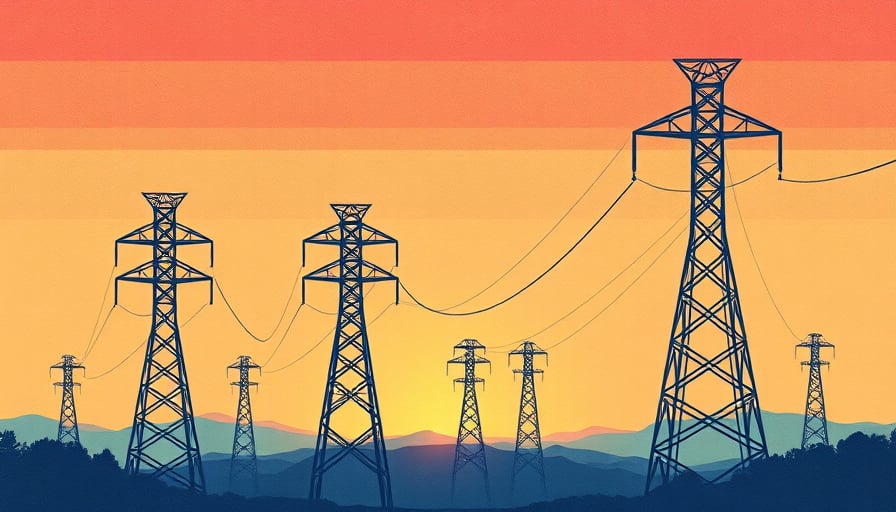Corporate News
Xcel Energy Inc., a publicly traded electric and natural gas utility on the Nasdaq, has submitted a comprehensive proposal to the Colorado Public Utilities Commission (PUC) requesting a significant augmentation of its rate base. The company contends that the proposed hike is essential to recoup capital expenditures incurred over the preceding three years in the upgrade of distribution, transmission, and generation assets. If the PUC grants approval, the average residential electric bill in Colorado would rise by roughly ten percent, with the increase slated to take effect in September 2026. The PUC will conduct a series of testimony sessions and a public hearing before rendering a decision. Meanwhile, Xcel’s shares have experienced moderate gains over the past year, mirroring the broader trend in utility equities.
Investment Rationale and Infrastructure Modernization
Xcel Energy has disclosed that its recent investments were driven by multiple imperatives:
- Grid Resilience and Reliability – Upgrades to the distribution network, including the deployment of high‑capacity voltage‑control devices and advanced fault‑location, isolation, and restoration (FLIR) systems, aim to mitigate outages precipitated by extreme weather events.
- Transmission Capacity Expansion – Construction of new 345 kV corridors and reinforcement of existing lines are intended to accommodate anticipated load growth and the interconnection of intermittent renewable resources.
- Generation Portfolio Diversification – Capital has been allocated to a mix of natural gas peaking plants, battery energy storage systems (BESS), and solar photovoltaic (PV) farms to enhance dispatch flexibility and provide ancillary services such as frequency regulation and voltage support.
The cumulative cost of these initiatives is projected to exceed $2.1 billion over a five‑year horizon, with a significant portion earmarked for integration of distributed energy resources (DERs) and demand‑response programs.
Grid Stability and Renewable Energy Integration
The Colorado electric grid is undergoing a rapid transformation, with renewable penetration projected to reach 45 % of total generation capacity by 2035. This transition introduces several technical challenges:
- Voltage Regulation – Solar PV and wind farms generate power at varying levels, necessitating sophisticated voltage‑control strategies (e.g., Volt/VAR control) to maintain system voltage within ±5 % of nominal.
- Frequency Regulation – As base‑load nuclear and coal generation decline, the grid relies increasingly on fast‑response resources such as BESS and flexible gas turbines to absorb frequency deviations.
- Transient Stability – High inverter penetration can affect system damping; coordinated control of inverter‑based resources is required to preserve stability during fault conditions.
Xcel’s investment in real‑time monitoring, wide‑area measurement systems (WAMS), and predictive analytics aims to address these dynamics, thereby ensuring compliance with the North American Electric Reliability Corporation (NERC) standards for bulk power system reliability.
Regulatory Framework and Rate Design
Under Colorado law, utilities must justify rate increases through a cost‑of‑service analysis that balances the need for adequate investment with consumer protection. Key considerations include:
- Capital Cost Recovery – The PUC evaluates the proportion of capital expenditures to the existing rate base, ensuring that the proposed increase does not exceed the utility’s economic benefit to consumers.
- Energy Efficiency and Demand Management – Xcel’s proposal incorporates cost savings from planned energy‑efficiency programs, which are expected to offset a portion of the rate hike.
- Renewable Portfolio Standards (RPS) – The state’s RPS mandates that utilities procure a certain percentage of renewable energy, influencing both generation costs and the required investment in integration infrastructure.
The PUC’s decision will also hinge on the equity impact of the proposed increase, particularly on low‑income households. Xcel has submitted a preliminary equity analysis that projects a $120 average annual increase for the lowest‑income bracket, but the company maintains that these costs are offset by improved reliability and lower outage losses.
Economic Impact on Consumers and the Broader Market
A ten percent rise in average residential electric bills translates to an additional $400–$500 per household annually. While the increase may raise concerns among consumers, the economic analysis suggests several mitigating factors:
- Reliability Premium – Reduced outage frequency and duration can lower indirect costs related to lost productivity and health impacts.
- Investment in Renewable Integration – Long‑term, the cost of renewable generation is decreasing; early investment now can accelerate the transition to lower‑carbon energy sources, potentially reducing future price volatility.
- Consumer Price Index (CPI) Stability – By maintaining adequate investment, utilities can avert costly emergency upgrades, which historically have led to steeper rate hikes in the future.
From a market perspective, utility stocks have displayed resilience amid regulatory scrutiny, reflecting investor confidence in the sector’s essential nature. Xcel Energy’s stock performance, although moderate, aligns with the broader trend of utility equities benefitting from regulated revenue certainty and the increasing demand for renewable infrastructure.
Conclusion
Xcel Energy’s request to augment its rate base underscores the delicate balance between infrastructure modernization and consumer affordability. The proposed investments aim to fortify grid stability, facilitate higher renewable penetration, and meet evolving regulatory expectations. The PUC’s forthcoming decision will not only set a precedent for future rate adjustments in Colorado but will also signal how utilities can navigate the technical, economic, and regulatory challenges inherent in the energy transition.




